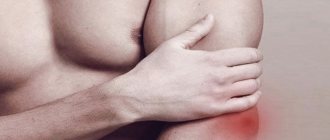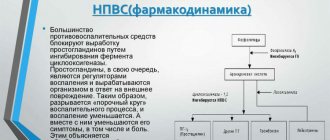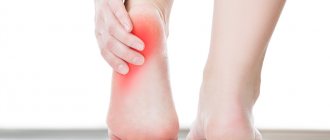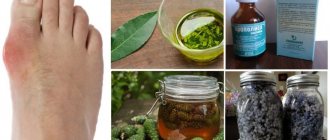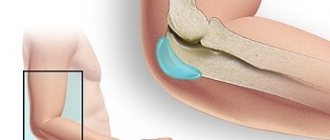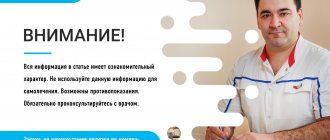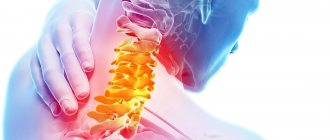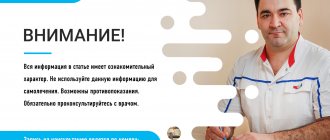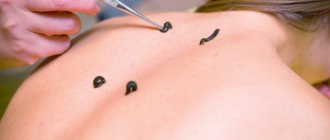Osteochondrosis of the scapula is a diagnosis that actually does not exist. The term osteochondrosis itself means degenerative dystrophic destruction of cartilage (chondro) and bone (osteo) tissue. The scapula is a flat, triangular bone that has no articulations with the spine and is not covered with a cartilaginous synovial layer. Therefore, osteochondrosis in the scapula area cannot, by definition, develop.
But symptoms of osteochondrosis in the scapula area may indicate that treatment should be carried out for arthrosis of the shoulder joint or acromioclavicular joint. Typically, osteochondrosis in the scapula area develops after traumatic exposure. Both the thoracic and cervical spine can be affected. With cervical osteochondrosis, compression of the radicular nerve may be observed in the area of the scapula, which causes severe pain. Thoracic osteochondrosis of the spine between the shoulder blades manifests itself in the form of characteristic pain and a feeling of stiffness in movements. In the later stages of the pathology, difficulties may arise with raising the arms and performing rotational movements. A prolonged immobilized state gradually leads to the development of a secondary form of osteoarthritis of the shoulder and acromioclavicular joints.
Therefore, it is important during the initial diagnosis to examine these bone joints and exclude the possibility of developing pathological changes at an early stage. Secondary glenohumeral periarthritis often leads to the development of deforming osteoarthritis and loss of the ability to perform habitual actions with the upper limb on the affected side.
The danger of osteochondrosis lies in the nature of this disease. It is degenerative dystrophic, i.e. associated with malnutrition leading to tissue destruction. At the initial stage of development of osteochondrosis, diffuse nutrition is disrupted, carried out by the exchange of fluids between the cartilaginous tissues of the fibrous ring of the intervertebral disc and the surrounding muscles.
Many of these muscles attach to the shoulder blade. These are the pectoralis minor, coracobrachialis, serratus anterior, long head of the triceps brachii, biceps brachii, subscapularis, rhomboid major, rhomboid minor, levator scapulae, trapezius, deltoid, supraspinatus, infraspinatus, teres major and teres minor. All these muscles are partially involved in providing diffuse nutrition to the cartilage tissue of the intervertebral disc. But only if they work fully and experience sufficient and regular physical activity. If a person leads a sedentary lifestyle and does not exercise regularly, then these muscles partially atrophy and cannot provide sufficient nutrition to the cartilage tissue. Osteochondrosis begins. As the disease develops, the following occurs:
- the fibrous ring of the intervertebral disc gradually loses fluid and becomes dehydrated;
- elasticity and the ability to withstand significant physical and mechanical loads are lost;
- a network of small cracks appears on the surface (so far they are not through and the nucleus pulposus cannot partially pass through them);
- to restore integrity, calcium salts settle on the surface of the cracks - this leads to the fact that the intervertebral disc loses the ability to fully absorb fluid during diffuse nutrition in the future;
- fluid intake begins from the tissues of the nucleus pulposus located inside the fibrous ring;
- it loses its mass and shock-absorbing ability;
- the intervertebral disc decreases in height and increases in area - this is the stage of protrusion, it gives a pronounced constant pain syndrome due to compression of the surrounding soft tissues;
- Even a slight increase in physical activity at this stage can lead to rupture of the fibrous ring and exit through the resulting through crack of the nucleus pulposus - this is the stage of formation of a disc herniation.
Thus, osteochondrosis triggers a degenerative dystrophic process not only in the area of intervertebral discs. All muscles of the back, collar area and neck suffer. They first undergo dystrophic changes, then excessive static stress in order to compensate for the lost physiological height of the disc. When innervation is disrupted, the process of trophic atony of myocytes starts.
Symptoms of osteochondrosis of the scapula
This is usually a dull aching pain. They arise below the occipital zone. The pain can radiate to the armpit, shoulder and shoulder blade. As a rule, the pain is one-sided. It can be confused with pain from myocardial infarction.
IMPORTANT: The difference between such pain and cardiac pain is that it increases with any movement, as well as intensifies with pressure in the painful area. Painful sensations are caused by staying in one position for a long time, for example, while sleeping, when working in an office, or when driving a vehicle.
With increasing load on the cervical region, on the shoulders, and with sudden movements, the pain intensifies
Painful sensations are caused by staying in one position for a long time, for example, while sleeping, when working in an office, or when driving. With increasing load on the cervical region, on the shoulders, and with sudden movements, the pain intensifies.
httpv://www.youtube.com/watch?v=embed/h9B8b5ZF3wY
In some cases, a feeling of coldness, tingling, or, less often, slight numbness occurs between the shoulder blades. The severe aching pain is very annoying.
Every inhalation and exhalation hurts. Coughing and sneezing make the situation worse. There may be numbness and loss of sensation in the arm down to the fingertips.
Osteochondrosis of the scapula is characterized by difficulty moving the arm in the shoulder joint. When moving, a sharp shooting pain occurs, which intensifies when the arm is moved to the side or behind the back. Instinctively, a person tries to protect his hand from pain and presses it to his body.
In addition, the person experiences attacks of dizziness and begins to “drift” to the sides. Patients often complain of recurring headaches, feelings of fatigue and back discomfort.
Read: Radicular syndrome in osteochondrosis
Pain can occur between the shoulder blades on both the right and left
It is very important to correctly diagnose, identify concomitant diseases and differentiate
Diagnosis is made by excluding diseases with similar symptoms. The most commonly used are radiography, followed by CT and MRI. The most informative diagnosis is MRI in an upright position, when the spine is under physiological load.
Pain under the shoulder blade: which doctor should I contact?
If you complain of pain under the shoulder blade, it is recommended to consult a general practitioner (general practitioner or family doctor). It is the general practitioner who must determine which specialists should be examined.
If the pain under the shoulder blade is associated with eating, accompanied by heartburn, belching, or a feeling of bitterness in the mouth, you will probably need to consult a gastroenterologist.
If there is reason to believe that the pain is related to the spine, for example, if the pain intensifies with movement of the torso or shoulder, then you will be referred to a neurologist, vertebroneurologist or chiropractor.
You must be prepared that you may need to consult a cardiologist or urologist.
Therapy
It is not so easy to cure osteochondrosis, especially in elderly patients. But it is quite possible to alleviate the general condition with the help of physiotherapeutic procedures.
A simple massage will help relieve muscle spasms. From gymnastics you can do the following exercises to develop flexibility:
- Circular movements of the shoulders;
- Raising your arms at shoulder level in different directions;
- You can clasp your hands, alternately changing position;
- Wrapping your arms around your chest, you need to try to spread your shoulder blades to the maximum.
In everyday life and in the workplace (if the work involves forced long-term sitting in one state), comfortable conditions should be created; the muscles of the neck and thoracic spine should not be in constant tension; posture should be kept straight. During breaks, it is advisable to perform several exercises.
To prevent osteochondrosis from causing trouble, it is better to purchase a bed and.
Denial of responsibility
The information in the articles is for general information purposes only and should not be used for self-diagnosis of health problems or for therapeutic purposes. This article is not a substitute for medical advice from a doctor (neurologist, therapist). Please consult your doctor first to know the exact cause of your health problem.
I will be very grateful to you if you click on one of the buttons and share this material with your friends
A fairly common disease is scapular osteochondrosis, the symptoms and treatment of which you need to know. It is characterized by a violation of the structure of connective tissue.
Effective therapeutic techniques
After determining the root cause of interscapular pain, the patient may need to consult with a cardiologist, neurologist, or gastroenterologist. Until you receive medical help, you can try to relieve the pain syndrome on your own; you should not endure it for long. There are some harmless methods to relieve pain.
Gymnastic exercises
A gymnastics complex will help relieve discomfort:
- We place our palms on our shoulders and perform several circular movements back and forth.
- We raise our palms to the top, then our arms completely, lock them together, lower our heads, and concentrate our gaze on the fingers.
- We bring and spread the shoulder blades.
- We perform body turns alternately to the right and left.
Medicines
Taking medications without medical advice is contraindicated, as this may worsen the situation.
In cases where the cause of pain in the intervertebral region is associated with spinal diseases, the doctor may prescribe treatment with drugs from the NSAID group:
- Diclofenac;
- Indomethacin;
- Movalis;
- Ibuprofen;
- Nimesulide;
- Meloxicam;
- Naproxen;
- Voltaren, etc.
As an auxiliary therapy, the affected area can be treated with external agents: Fastum gel, Capsicam, Amelotex, Nise gel.
After the pain has eased, you can resort to local medications with an irritating effect:
- Efkamena;
- Menovazina;
- Finalgona.
Treatment options
For subscapular osteochondrosis, complex treatment is prescribed. For this purpose, drug therapy, massage and other means are used. In advanced cases, an operation is applied.
Medication
For shoulder osteochondrosis, the following drugs are prescribed:
- Anti-inflammatory drugs. When drawing up a course of treatment, the patient’s age, symptoms, and the presence of concomitant pathologies are taken into account. Incorrect and long-term use of some medications causes complications.
- Muscle relaxants. The disease is accompanied by muscle spasms. These medications can help relieve symptoms.
- Chondroprotectors. Widely used to treat osteoarthritis and osteochondrosis. The course of taking the drugs is at least 3 months.
- Antidepressants. Medicines are prescribed for chronic pain.
- Analgesics. Prescribed in difficult cases, taking into account individual indications.
It is recommended to use local remedies such as ointment or cream as painkillers. This reduces the risk of complications.
Massage and exercise
Exercise therapy has a very good therapeutic effect. When performing exercises at home, you should follow some conditions:
- you need to start with light loads;
- patients suffering from arthrosis of the joints do exercises while sitting or lying down;
- heavy loads and sudden movements during gymnastics are prohibited;
- lifting heavy weights is contraindicated;
- loads should not be painful.
As for therapeutic massage, it is prohibited in case of pronounced symptoms. In any case, it should be carried out by a professional. It is not recommended to do it at home, as complications may arise later.
Massage for osteochondrosis should be performed by a professional
Operation
Surgery for this pathology is performed extremely rarely. Indications for the operation include:
- hernias;
- pain and severe discomfort;
- protrusions accompanied by severe pain;
- neuralgia;
- decreased sensitivity on the left and right;
- restriction of movements.
ethnoscience
To eliminate the unpleasant symptoms of osteochondrosis of the scapula, folk remedies are widely used, among which it is worth highlighting:
- Aloe juice. To prepare the solution I use 50 g of juice, 100 g of honey and 80 g of alcohol. Mix everything thoroughly and leave for 12 hours. Compresses are done 2 times a day. It should remain on the affected area until it dries completely.
- Bay leaf. To prepare the infusion, you need to take 17 leaves of the plant and pour vodka (0.5 l). It is infused for 3 days. It is used to rub the shoulder blade area.
Osteochondrosis between the shoulder blades is accompanied by symptoms that hinder movement, cause discomfort and reduce quality of life. Therefore, at the first manifestations of the disease, you should consult a doctor. After diagnosis, the specialist will prescribe effective treatment that will get rid of the pathology and eliminate discomfort.
httpv://www.youtube.com/watch?v=embed/o1TbMGy-_X4
When you need a doctor for pain under the shoulder blade
If the pain under the shoulder blade appeared for the first time and quickly passed, then it was probably associated with an accidental cause - for example, the body was in an uncomfortable position for a long time. If the pain persists, intensifies or causes discomfort (in case of severe pain), you should definitely consult a doctor.
In some cases, emergency medical attention is required. Call an ambulance if:
- pain under the shoulder blade is associated with injury. Especially in the presence of bleeding and signs of bone fracture;
- along with pain, deformation, swelling, edema or redness in this area is observed;
- pain is accompanied by increased heartbeat, difficulty breathing (shortness of breath, feeling of lack of air);
- the pain is accompanied by dizziness and faintness.
Therapy
In the stage of exacerbation of osteochondrosis, treatment is aimed at relieving pain and relieving the inflammatory process. The most acceptable are non-steroidal drugs that have anti-inflammatory and analgesic effects: Meloxicam, Ketoprofen, Diclofenac. To minimize pain syndromes, blockade with Diprospan is used. The suspension is injected into the area of maximum pain at an angle of 60-90 degrees.
To immobilize the limb, special supporting bandages are used. In parallel with drug treatment, the following is prescribed:
- magnetic therapy;
- laser procedures;
- acupuncture;
- massage;
- manual influence on damaged areas of the spine;
- post-isometric relaxation to reduce pain.
Gymnastic exercises
How to treat osteochondrosis when the exacerbation is stopped? An effective remedy is special exercises aimed at strengthening the muscles of the spinal column.
Properly selected gymnastics has many positive effects:
- forms correct posture;
- restores flexibility and mobility to the vertebrae;
- eliminates pain;
- relieves muscle tension;
- improves blood microcirculation;
- improves metabolic processes;
- eliminates pinched blood vessels.
httpv://www.youtube.com/watch?v=embed/tY_sS673bgs
Before starting exercises, it is necessary to warm up the problem area. Water procedures and warming ointments are suitable for this. Gymnastics is performed with smooth movements without sharp turns and jerks.
For thoracic osteochondrosis, the following exercises are recommended:
- In a standing position. Place your feet shoulder-width apart and place your hands on your waist. Bend as far as possible to the side, forward and backward without bending your knees.
- Sit on a chair with your feet flat on the floor. As you inhale, squeeze your shoulder blades together, as you exhale, spread them apart.
- Sit on the floor, straighten your legs in front of you. Turn your torso to the right as much as possible, then to the left, simulating twisting.
- Get on all fours. Arch your back and stay in this state for 5-7 seconds. Round it, imitating a cat stretching. Fix your back for 2-3 seconds.
Repeat all exercises 5-10 times.
After a set of gymnastic procedures, stretch your spine. To do this, sit on a chair and bend down as much as possible, feeling how the vertebrae begin to stretch under the weight. Slowly straighten up and lean back.
ethnoscience
Alternative treatment can be combined with drug therapy. An effective remedy is considered to be an ointment made from cinquefoil with the addition of lard, which can be prepared at home:
- Grind a tablespoon of dry herb.
- Add 30 grams of rendered fat.
- Stir.
- Rub the ointment onto the inflamed area, cover with cling film and wrap with a woolen scarf.
Folk remedies include vinegar and onion compresses, poultices with burdock root, lotions with horseradish and vodka tincture.
Treatment is not complete without healing baths with spruce or juniper cones. To do this, 500 g of raw material is brewed with 3 liters of boiling water and infused for 1-2 hours. The resulting decoction is added to water. The bath is taken for half an hour. Treatment and prevention of scapular osteochondrosis is carried out comprehensively. The earlier the disease is diagnosed, the easier it is to cope with the pathology without any complications. It is necessary to listen sensitively to your body and, when the first symptoms appear, undergo a diagnosis from a qualified specialist.
We also recommend reading:
▲
Treatment of pain on the right side of the shoulder blade
Pain treatment must begin with diagnosis, since effective pain management is only possible if you know its cause. Symptomatic therapy based on the use of analgesics does not treat the cause of pain, but only temporarily alleviates the most severe symptom. After making an accurate diagnosis, it is possible to treat the underlying disease by influencing the factors that led to it.
This is also important because without knowing the cause of the pain, it is difficult to choose the right treatment. Thus, attempts to treat pain in the scapula on the right side with analgesics in acute cholecystitis can lead to complications in the form of gangrene of the gallbladder, its perforation and extensive peritonitis, with a high risk of death. Painkillers are strictly contraindicated for acute surgical diseases of the abdominal organs.
Causes and symptoms
Scapular osteochondrosis, like cervical osteochondrosis, develops for several reasons:
- Destructive processes affecting the place where the shoulder blade and shoulder bone connect. As a result of these processes, metabolism is disrupted, nerves and blood vessels are damaged.
- Accumulation of calcium salts.
- Muscle strains.
- Scoliosis and other posture problems.
- Infections.
- Lack of movement, for example during sedentary work.
- Excessive stress on the shoulders.
Symptoms of scapular osteochondrosis are quite varied:
- Pain in the area of the shoulder blades. In most cases it is felt during sleep.
- Feeling of stiffness when moving your shoulders.
- Pain in the whole arm.
- Excessive fatigue, both physical and mental.
- Unpleasant sensations when coughing or sneezing.
- A crunch that is heard when moving the shoulder blades.
- Swelling of the hands.
- Severe sweating of the palms.
The listed symptoms are not enough to confirm the diagnosis. To obtain additional data, the doctor usually prescribes the following procedures:
- ,
- ,
- CT.
Based on the data obtained, he prescribes treatment.
Factors contributing to pain between the shoulder blades
Painful sensations in the interscapular area can occur against the background of some vertebral pathologies:
- osteochondrosis of the thoracic region;
- problems with posture (kyphosis, scoliosis, kyphoscoliosis);
- spondyloarthrosis;
- humeroscapular periarthrosis;
- protrusion and intervertebral hernia in the thoracic region;
- intercostal neuralgia;
- radiculitis;
- spinal column injuries.
Problems in the functions of the spine can develop:
- during sedentary work;
- in the absence of sports;
- under significant loads for which the body is not ready.
More than one spine may be the source of the problem. Painful manifestations may occur against the background of disturbances in the functioning of internal organs. For example, the presence of cardiac pathologies: angina pectoris, coronary artery disease.
In addition, pain syndrome can develop against the background of:
- hepatitis A;
- cholecystitis;
- peptic ulcer in the stomach;
- pulmonary diseases;
- infectious pathologies.
Often, people who move little due to the specific nature of their work activity have to face a similar problem, since their muscular and ligamentous systems are weakened, and the muscle fibers in the shoulder girdle are tense for a long time. Such pain often bothers drivers, garment factory workers, etc.
Osteoporosis of the shoulder joint symptoms and treatment of the shoulder
Have you been struggling with JOINT PAIN for many years without success?
Head of the Institute: “You will be amazed at how easy it is to cure your joints by taking the product every day for 147 rubles...
Osteoporosis is a serious metabolic disorder affecting connective tissues. As pathology develops, healthy bones become fewer and fewer. Due to a decrease in tissue density, displacements and even fractures may occur.
There are several types of osteoporosis:
- generalized;
- regional;
- local.
All of the varieties mentioned have a number of differences, which means that treatment is selected on an individual basis.
Osteoporosis of the shoulder joint is a regional pathology. This is explained by the fact that the connective tissue disorder remains in this area. In other words, the pathological process will not spread to adjacent healthy bones.
The shoulder joint is represented by two parts of bones: the glenoid fossa of the scapula and the head of the humerus. The joint itself is attached by only one ligament, which allows movements in any direction.
Etiology of osteoporosis
Osteoporosis of the shoulder most often develops for the following reasons:
- systemic and autoimmune diseases, including lupus erythematosus, rheumatism, systemic scleroderma and rickets;
- liver and kidney failure;
- pathologies of the endocrine system, namely thyrotoxicosis and hypoparathyroidism;
- various intoxications, including those caused by alcohol and drug use;
- tumors, including sarcoma, adenoma and pheochromocytoma;
- neuropathy and angiopathy;
- injuries and surgical interventions affecting the affected area;
- bacterial infections, namely osteomyelitis and bone tuberculosis.
Main features
As pathology develops, healthy cells are destroyed, resulting in the bone becoming empty and brittle. This is what explains the formation of cracks and frequent fractures.
Osteoporosis of the lumbar spine and shoulder joint at an early stage has no signs. However, over time, the first symptoms appear. We are talking about pain in the affected area, numbness and impaired motor function. As the pathology develops, such manifestations worsen, making it difficult for the patient to work and even sleep.
At the initial consultation, patients complain of the above symptoms. At this point, the doctor should ask a number of questions to the patient, which will help establish the exact reason why osteoporosis of the foot or shoulder occurred, and pain in the shoulder joint becomes one of the criteria.
In the case of pathology affecting the shoulder joint, frequent fractures are observed, because in this area the tissues themselves are quite thin.
Diagnostic methods
If osteoporosis of the lumbar spine or shoulder joint is suspected, palpation must be performed. During its implementation, the patient complains of stabbing acute pain.
Naturally, this diagnostic method is not enough. The doctor is obliged to refer the patient for an x-ray. Thanks to him, it will be possible to verify the development of pathology and assess its volume.
Laboratory diagnostics is considered equally important. Similar methods allow you to determine the quantity:
- parathyroid hormone,
- phosphatases,
- calcium
- and other microelements.
Treatment of pathology
Osteoporosis of the foot or shoulder must be treated based on the cause of its development. For endocrine etiology, replacement therapy is indicated, and for autoimmune etiology, the use of glucocorticosteroids, namely prednisolone and cortisol. If the cause is intoxication, then you first need to eliminate it. This will help relieve pain in the affected area.
There are sets of exercises for the shoulder joint that provide faster recovery from illness. Thanks to them, it will be possible to normalize motor function and strengthen the joint. To enhance this effect, it is worth reviewing your diet.
The video in this article will help the reader learn how to strengthen bones with osteoporosis and how to prevent this problem.
httpv://www.youtube.com/watch?v=embed/BsrpWDFIxvI
Exercise therapy for osteochondrosis
One of the important points in the treatment of spinal osteochondrosis is physical therapy. It allows the vertebrae to return to the correct position, improves blood supply to tissues, and strengthens the ligaments that hold the spine. A set of therapeutic exercises is selected for the patient individually and depends on the degree of complexity of the pathological process, its manifestations, capabilities and age of the person.
When performing physical therapy, it is important to adhere to some principles:
- regularly perform the exercises prescribed by your doctor, without missing classes without good reason;
- increase the load gradually so as not to overload the already weakened spine;
- work on your back without overworking it (increased activity can provoke an exacerbation of the disease and increase pain in the back).
To develop a truly effective set of exercises for osteochondrosis, a person needs to contact a qualified specialist.
Character
Aching one-sided pain between the shoulder blades may also appear. Such pains occur more often in the morning, or, as well as while taking a hot bath. In the latter case, the pain is accompanied by dizziness and numbness of the hands.
Pain between the shoulder blades may also indicate the presence of osteochondrosis, spondyloarthrosis, scoliosis and other equally dangerous diseases.
Osteochondrosis can manifest itself as pain under the left shoulder blade. Pathology can occur due to the presence of scoliosis, disc protrusion, or as a result of injury.
Osteochondrosis is also characterized by pain under the right shoulder blade. This indicates that the nerve compression occurred on the right side of the spinal column in the chest area. If the nerve root, which is caught “in a vice” between the vertebrae, comes out to the right of the skeleton, then the right shoulder blade hurts due to osteochondrosis.
When your shoulder blade hurts due to osteochondrosis, you will have to spend a long time in the chiropractor’s office. Conservative methods for moderate pain are not used.
Treatment is aimed solely at stretching the spine and releasing pinched nerves. As a rule, pathology in the area of the shoulder blades is difficult to restore.
Therefore, the patient should be patient and change their lifestyle and diet. Back correction also occurs due to.
Treatment of osteochondrosis: cost of treatment in Naberezhnye Chelny
Are you worried about spinal osteochondrosis? Don’t hesitate for a long time, but immediately seek qualified help from specialists in Naberezhnye Chelny. You can find out more about the doctor by following the link.
All employees of our clinic have high competence and many years of experience working with patients who suffer from the consequences of degenerative changes in the spinal column. With us, everyone is guaranteed to be able to receive competent advice and effective treatment of the problem. We offer only high-quality services at the most affordable prices in the region. More information about the prices of our clinic can be found here.
You can make an appointment by calling the phone numbers: +7 (8552) 78-09-35, +7 (953) 482-66-62.
Clinical picture
Thoracic osteochondrosis occurs much less frequently than in the cervical and lumbar regions, since this part of the spine is inactive and protected by a muscular frame. However, against the background of childhood scoliosis, a sedentary lifestyle, and circulatory disorders in this area of the ridge, degenerative processes develop that affect the intervertebral discs. Drying of the cartilage tissue leads to uneven distance between the vertebrae.
A shift in the center of load causes the bone tissue to begin to compensate for the lack of cartilage through bone growths - osteophytes. This complication is called spondylosis and can develop independently, in the presence of injuries and inflammatory processes in the spine, or against the background of osteochondrosis.
Thoracic spondylosis in the initial stage causes practically no unpleasant sensations, except for stiffness of movements in the morning, but as osteochondrosis progresses, the formation of growths in the posterolateral region is possible, and this is fraught with infringement of the nerve processes emerging from the spinal cord. Radicular syndrome is manifested by acute pain localized between the shoulder blades, and also radiating to the internal organs - heart, lungs, liver. The danger is that the pinched nerve is not able to receive and transmit the appropriate signals to the brain that ensure the functioning of the internal organs, which over time can lead to their dysfunction.
Cervical osteochondrosis, accompanied by pain in the left scapula, has specific symptoms of pain localization, depending on which root is pinched. So, when the 6th root is pinched between the 5th and 6th cervical vertebrae, the pain spreads from the left shoulder blade along the outer surface of the shoulder and radiates to the thumb. With 7th root syndrome, pain is observed spreading from the left shoulder blade and neck along the inner surface of the arm and radiating to the middle finger or little finger.
Thoracic osteochondrosis is characterized by a burning sensation between the shoulder blades or acute pain radiating to the heart. Sometimes, with a sharp, awkward movement or cough, lumbago on the left side appears - acute short-term pain that intensifies with inhalation.
Symptoms accompanying painful manifestations
Using additional signs, you can quickly identify the cause of pain between the shoulder blades.
A feeling of numbness in the back appears against the background of:
- osteochondrosis;
- curvature of the spinal column;
- humeroscapular periarthritis;
- pleurisy;
- cardiac ischemia;
- biliary dyskinesia.
The appearance of itching in the back area is characteristic of diseases such as herpes zoster and biliary colic. If a feeling of chills occurs, we can talk about an exacerbation of pyelonephritis or infringement of nerve receptors in the spinal canal.
High temperature is characteristic of pathologies of internal organs:
- pancreatitis;
- pneumonia;
- tuberculosis;
- hepatitis;
- cholecystitis;
- jade.
Cough syndrome in combination with pain in the interscapular area appears against the background of problems with the lungs and bronchi. A typical symptom of impaired pulmonary function is difficulty breathing.
The appearance of vomiting is characteristic of peptic ulcers in the stomach, liver and kidney diseases, and myocardial infarction. The appearance of belching may indicate damage to the upper digestive tract.
Pain in the interscapular region is only a symptom. To achieve positive results and eliminate discomfort, you need to begin treating the underlying disease.
Why does osteochondrosis occur in the scapular area?
The main causes of scapular osteochondrosis are pathological changes in the area of the junction of the scapula and the humerus. Disruption of metabolic processes in cartilage tissue leads to its structural changes, dystrophy and decreased elasticity of joints. As a result, friction of bone structures and muscle spasms cause pinching of blood vessels and nerve endings, which leads to pain, impaired blood flow and provokes neuralgia.
Factors causing pathological deformation:
- genetic predisposition;
- unbalanced diet;
- hypertonicity of the thoracic muscles due to chronic overexertion;
- large body weight;
- physical inactivity;
- diseases of the musculoskeletal system;
- frequent strain associated with lifting heavy weights;
- spinal injuries;
- intoxication of the body;
- infectious diseases without timely treatment;
- prolonged stressful situations;
- age-related changes.
Typically, joint pain bothers patients at night. This is due to pinched nerve endings and compression of blood vessels. Raising the elbow and supporting it reduces pain syndromes. An unnatural position of the head to relieve discomfort aggravates the disease process - blood circulation is disrupted, and there is a poor supply of oxygen to the brain.
Symptoms
Cervicoscapular osteochondrosis has numerous manifestations. Sometimes the disease is called a “chameleon”, since the clinical picture resembles pulmonary, heart, and liver diseases. The doctor’s qualifications and instrumental studies help to establish the true cause of the pathology.
The main symptoms of scapular osteochondrosis:
- stiffness when moving the shoulders;
- irradiation of pain into the arm;
- increased discomfort in the area of the shoulder blades when turning the body, lifting weights, taking deep breaths and exhales;
- pain under the right shoulder blade;
- discomfort when coughing, sneezing;
- crunch in the scapular area;
- swelling of the hands;
- sweaty palms;
- neurological disorders, manifested in numbness of the lower extremities, a sensation of pins and needles in the lower abdomen.
In some cases, the patient complains of heart attacks with respiratory arrest, acute pain in the chest area. Usually, all signs of scapular osteochondrosis occur alternately. In advanced conditions, combinations of several symptoms may occur.
Treatment and prevention
Pain radiating to the scapula with osteochondrosis requires adequate treatment depending on the degree of development of the disease and the presence of complications.
Osteochondrosis of the first and second degrees without the presence of protrusions and hernias can be treated with therapeutic methods, which include:
- Taking medications such as chondroprotectors that nourish the cartilage plate, muscle relaxants that relieve spasms and increase blood circulation, as well as anti-inflammatory drugs in the presence of pain.
- Physiotherapy eliminates congestion during inflammation, improves nutrition of cartilage tissue and vertebrae, and restores blood circulation. The most effective methods for cervical and thoracic osteochondrosis are electrophoresis, balneotherapy, hirudotherapy, detensor therapy, exposure to electromagnetic waves, and ultraviolet heating. If there is a hernia or protrusion of the fibrous ring, physiotherapy is contraindicated.
- Therapeutic exercise is used during the rehabilitation period and as one of the main ways to prevent osteochondrosis. The most effective strength exercises are for the chest and shoulder girdle, which involve dumbbells and a pole. Yoga and Pilates also have a beneficial effect on the condition of the spine and muscle corset. If there is no radicular syndrome, you can go swimming and running.
- Massage also helps to increase blood supply to the spine, removes lactic acid from the muscles, and stimulates metabolic processes.
Pain radiating to the left shoulder blade with radicular syndrome is eliminated through drug treatment. Non-steroidal anti-inflammatory drugs are used in the form of ointments and injections to eliminate swelling of soft tissues, as well as muscle relaxants to reduce muscle spasms. Thus, the pressure on the spine from the soft tissues is reduced and the nerve pinched between the muscles and vertebrae, which causes pain in the left shoulder blade, takes its usual position.
Mineral and mud baths have a good effect on radicular syndrome, improving blood flow, relieving tension and muscle spasms, and improving the functioning of the nervous system. Between such procedures, you can do a relaxing massage, as well as stone therapy - relaxation massage using cold and warm stones.
Before starting therapy, the doctor must take an x-ray of the pathology and, based on it, prescribe further treatment.
httpv://www.youtube.com/watch?v=embed/j4WhjkxkX3c
Our readers recommend:
ratings, average:
out of 5)
Osteochondrosis is the process of wear and tear of the cartilage discs of the spine. This is a natural age-related process. The aging of the human body begins precisely with the wear and tear of the spinal discs, on average at 25 years of age.
Sergey Bubnovsky: “With the right approach, joints are treated well. Our Center was the first in Russia to discover and certify access to the newest drug for joint pain."
read more
The degree of development of osteochondrosis in people of the same age can have significant differences. This depends on many factors, including lifestyle, heredity, and metabolic disorders.
Read: What ointments are used for osteochondrosis
The following factors provoke the occurrence of osteochondrosis:
- excessive and improperly distributed loads;
- vibration;
- flat feet;
- physical inactivity;
- overweight;
- unfavorable climatic conditions, including high humidity and low temperatures.
Often osteochondrosis of the cervical and thoracic spine is manifested by pain in the area of the shoulder blades.
Prevention of osteochondrosis
To prevent the development of spinal osteochondrosis in a person, experts recommend paying attention to the following preventive measures:
- a healthy night's rest and sleep on a flat mattress with an increased level of hardness;
- complete cessation of bad habits;
- increasing physical activity, avoiding prolonged sitting or any other forced position;
- adherence to the principles of healthy eating;
- systematic implementation of a set of physical therapy exercises recommended for osteochondrosis;
- periodic completion of a course of therapeutic massage.
Prevention of spinal osteochondrosis and prevention of exacerbations of the pathological condition requires wearing a special bandage or corset, which will help reduce the load on the back, strengthen its muscular corset and help keep the vertebrae in the correct anatomical position.
Hernia
Osteochondrosis of the left scapula can provoke the formation of a herniated disc. It is considered a complex, dangerous complication of the disease.
When a hernia occurs, the protective tissues of the intervertebral discs are completely destroyed. The protrusion occurs outward, beyond the spine, into the canal with the cerebrospinal fluid. A hernia is dangerous because it completely compresses the spinal roots and compresses the spinal cord. Pain occurs when nerve endings are compressed.
A hernia can be accurately diagnosed using an MRI. Tomography determines the size of the hernia and determines the area of localization.
httpv://www.youtube.com/watch?v=embed/uYuTrOSy8lw
If a herniated disc has formed, it is not recommended to take hot baths, visit a bathhouse, or a sauna. The positive effect obtained after visiting the bathhouse is a deceptive phenomenon; after a while the condition will worsen and the pain will intensify.
The main causes of pain under the right shoulder blade
Let's look at the main causes of back pain in the area of the right shoulder blade. Do not forget, the presence of this symptom may indicate a serious surgical disease that requires emergency medical attention.
Gallbladder diseases
Back pain in the area of the right shoulder blade is a common symptom in acute or chronic cholecystitis (inflammation of the gallbladder). Thus, local pain in the area of the inner corner of the right scapula, which increases with pressure, is called Kharitonov’s symptom - this is one of the specific signs of acute inflammation of the gallbladder. Similar points are present on the inside of the scapula in its lower part, and in the area of the transition of the scapula to the collarbone, on the right.
If there are stones in the gall bladder, which interfere with the flow of bile, intense abdominal pain occurs, radiating to the right shoulder blade, right shoulder, and interscapular space. The nature of the pain in the back is aching, pulling, while the pain in the abdomen is sharp, cutting, paroxysmal. If you have such symptoms, you should immediately consult a doctor for examination and to exclude acute surgical pathology.
Subphrenic abscess
Subphrenic abscess is an acute surgical disease, a complication of acute cholecystitis, appendicitis, and other surgical pathologies of the abdominal organs, in which pus accumulates. Most often, an abscess forms on the right, above the liver, and is accompanied by pain in the abdomen, lower back, and the right side of the back under the shoulder blade. Subphrenic abscess can also occur after surgery on the abdominal organs as a complication.
Bronchopulmonary diseases
Diseases of the bronchi and lungs, such as pleurisy, pneumonia, bronchopulmonary cancer, are almost always accompanied by pain in the chest and back. Due to the large number of pain receptors in the pleural cavity, pain can be sharp, acute, and intensify with breathing, coughing, and sneezing. The localization of pain is different and depends on the location of the focus in the lungs or pleural cavity.
Shpidonov Gennady Stanislavovich
Neurologist
Rostov State Medical University (neurology)
10 years of experience
Kidney diseases
Kidney diseases such as acute pyelonephritis, renal colic, kidney stones, abscess, cancer may be accompanied by pain in the shoulder blades. If the right kidney is affected, the patient will experience back pain under the right shoulder blade. If left, then left. The nature of the pain is sharp, pulling, cutting, paroxysmal, pain occurs simultaneously with pain in the lower back and hypochondrial areas in front. Fever, pain when urinating, nausea and vomiting are possible.
Diseases of the musculoskeletal system
Diseases of the musculoskeletal system are the main cause of pain in the shoulder blades. Among them are diseases such as spinal osteochondrosis, intervertebral disc herniation, scoliosis, spondyloarthritis and spondyloarthrosis. The source of pain can be a pathological muscle spasm that occurs due to instability of the spinal column, overstrain of the back muscles trying to compensate for the load on the sore back. It is characterized by constant aching pain that subsides with rest. With hernias and protrusions, pain can be caused by pinching of the spinal cord roots. The pain is sharp, acute, radiating to the shoulder blades, upper limbs, chest, and intensifies with physical activity and heavy lifting.
The immediate cause of pain behind the right or left shoulder blade from behind from the back may be associated with the shoulder blade itself, as happens with glenohumeral periarthritis. The disease occurs with degenerative-dystrophic damage to the shoulder joint, and is accompanied by inflammation of nearby soft tissues - muscles, ligaments and tendons. At the beginning of the disease, the pain is episodic in nature and occurs during physical activity, maximum elevation or abduction of the arm, and when throwing with the arm. Then they take on the character of constant pain, and bother you even at rest, sharply intensifying when you move your hand.
Muscle strain and inflammation
Muscle strain and inflammation (myositis) are common causes of pain in the shoulder blade, right or left. Pain occurs as a result of excessive physical activity, when playing sports, or lifting weights. As a result, microscopic ruptures of muscle fibers occur in the affected muscles, and minor hemorrhages are possible. Swelling and inflammation occurs at the site of injury. The pain is sharp and intensifies with movement and physical activity.
Myositis or muscle inflammation can be an independent disease that occurs due to hypothermia, draft, or intoxication due to acute respiratory viral infections. Less commonly, the disease is a consequence of autoimmune or rheumatic diseases. The pain is aching, prolonged, and intensifies with movement. The scapula area is affected quite often due to the presence of developed muscles.
Shpidonov Gennady Stanislavovich
Neurologist
Rostov State Medical University (neurology)
10 years of experience
Intercostal neuralgia
Neuralgia is attacks of sharp acute pain along the nerves, arising due to hypothermia, inflammation or irritation of the spinal cord roots in diseases of the spine. With intercostal neuralgia, pain spreads along the intercostal spaces and can be localized both under the right and left shoulder blades, behind the back, or on the sides and front of the chest. The pain is sharp, sharp, and worsens with breathing, movement, coughing or sneezing. The patient has to spare himself in attempts to relieve the pain, limiting the depth of breathing, trying not to cough or sneeze. In some cases, the pain can be so severe that it is necessary to resort to novocaine blockade of the intercostal nerves.
Diseases or injuries of the scapula
Diseases of the scapula that lead to pain include bruises, fractures and cracks of the scapula, benign and malignant tumors (sarcomas, osteochondromas, osteomas, etc.). Injuries occur due to direct physical impact (impact, falling on your back, traffic accident). A characteristic sign is pronounced swelling of the soft tissues in the area of the scapula, sharp acute pain, intensifying when moving the hand, crunching (in case of fractures, occurs due to friction of moving bone fragments).
With tumors, pain can be of a different nature, from aching, arching pain to severe pain. The pain is constant and not relieved by rest. Visually or by touch, a foreign dense and immovable formation in the area of the scapula associated with it can be determined.
Disc protrusion
Each vertebra is protected by a ring made of elastic connective tissue. With protrusion (when there is a change, complete destruction of cartilage tissue), protrusion of the vertebra occurs without rupture of the connective tissue. The protrusion is compared with a hernia of the spinal column in the initial stage of development. It is small in size and accompanied by pain. The reason for such obvious pathology of the spine is osteochondrosis under the shoulder blades.
Diagnosing protrusion is simple. Get examined with X-rays and MRI. Degenerative conditions of the vertebrae, identified not at an early stage of the disease, are cured using physiological procedures and conservative therapy. The doctor prescribes manual therapy sessions. Surgical operations are used more often.
Diagnostics
Timely and professional diagnosis allows us to identify the causes of pathological abnormalities. The clinical picture does not provide complete and reliable information about the causes of the disease. In addition to general tests, the specialist must prescribe a complete examination of the body.
During a visual examination, the doctor pays attention to the anatomical features of the patient. Using palpation, he identifies painful areas of the body, observes the range of movements and clarifies the symptoms.
Osteochondrosis of the thoracic region can be detected by:
- X-ray;
- CT scan;
- magnetic resonance examination.
On a note. To exclude cardiac pathologies, an electrocardiogram is prescribed. A kidney ultrasound and urine test can help identify kidney problems. Based on the data obtained, complex treatment is prescribed.
Drug treatment of osteochondrosis of the scapula
To eliminate pain under the left shoulder blade, the doctor prescribes anti-inflammatory drugs: Diclofenac or Ibuprofen. In some cases, he may prescribe a course of hormone therapy. Medicines are administered into the periarticular area. Diprospan, Flosteron and Metipred are usually used.
Diprospan is one of the popular drugs for the treatment of various diseases of the spine. It is produced in the form of a colorless suspension for injection, the active substance is betamethasone. This drug suppresses the activity of substances that cause pain and inflammation in the shoulder blades. In addition, it has antiallergic and immunosuppressive properties.
Diprospan is intended for people who are concerned about osteochondrosis, arthrosis, arthritis or ankylosing spondylitis.
The drug is contraindicated in patients with individual intolerance to its components, as well as in some pathologies specified in the instructions.
It is not recommended to use the product for the treatment of osteochondrosis by pregnant women and during lactation.
Diprospan injections block the painful process, accompanied by swelling, at the cellular level, eliminating pain and inflammation.
In addition to this drug, it is recommended to use chondroprotectors in complex therapy. They activate protective functions against the aggressive influence of Diprospan and quickly regenerate cartilage.
If, in case of scapular osteochondrosis, the doctor performs a blockade with Diprospan, then it should be diluted with Lidocaine. Sometimes Novocain is taken instead. It all depends on the sensitivity of each patient.
Side effects of Diprospan include the appearance of acne or dermatitis, increased sweating, sleep disturbance, irritability, depression, etc.
In addition to drug treatment, the patient will require physiotherapeutic procedures under the left shoulder blade. The most common are massage, manual therapy, yoga, reflexology, electrophoresis and physical therapy.
If a patient is found to have a deficiency of certain vitamins, he is prescribed intramuscular injections. Injections must be given within 14 days.
Massage under the left shoulder blade is a mandatory procedure for the complex treatment of pain in the shoulder blade area. It increases blood supply to the spine, removes lactic acid and improves metabolic processes.
You should only contact a chiropractor if the pain in the shoulder joint does not stop.
It is useful for the patient to visit the swimming pool and sauna during treatment.
It is important to note that due to prolonged pain, the patient experiences a decline in mood and is in a depressed state. Therefore, it is necessary to take sedatives and psychotropic drugs
One of the popular methods is hirudotherapy. Medical leeches have a positive effect on patients, eliminating pain. To alleviate the condition, 5-6 sessions are enough. A disadvantage of hirudotherapy is considered to be the manifestation of an allergy to leeches.
Surgery will be required if treatment has not brought a positive result within 3 months.
Treatment
Help before diagnosis
Most non-drug measures are aimed at preventing pain between the shoulder blades: developing and maintaining correct posture, eating a balanced diet without harmful foods, leading an active lifestyle and playing sports. In case of severe pain during the diagnostic search, the doctor prescribes non-narcotic analgesics, recommends limiting mobility, and, if necessary, prescribes strict bed rest.
Conservative therapy
In the treatment of back pain between the shoulder blades, a differentiated approach is used - the therapeutic regimen is selected individually, taking into account the leading disease that caused the symptoms and concomitant pathologies. In case of orthopedic problems, posture correction with the help of corsets and other orthoses comes to the fore. The following groups of medications are used to treat the causes of pain:
- Nonsteroidal anti-inflammatory drugs
. Prescribed to relieve discomfort in diseases of the osteoarticular system, as well as to eliminate inflammation and speed up recovery. NSAIDs are also effective for diseases of the respiratory organs and mediastinitis. - Antisecretory drugs
. Proton pump inhibitors and H2-histamine blockers are the basis for the treatment of GERD and achalasia cardia. The drugs reduce damage to the esophagus from acidic stomach contents and relieve pain. To quickly relieve the burning sensation, non-absorbable antacids are taken. - Antibiotics
. Massive antimicrobial therapy is indicated for acute forms of mediastinitis to destroy pathogens and prevent bacterial complications. Medicines are selected empirically. A combination of 2-3 agents is introduced to act on all possible types of microbes. - Cytostatics
. Polychemotherapy is selected for some forms of mediastinal cancer as preparation for surgery or as palliative care. Immunosuppressants are sometimes recommended for patients with severe forms of ankylosing spondylitis.
Patients with acute conditions (aortic dissection, fulminant mediastinitis) are hospitalized in the intensive care unit. The goal of treatment is to get rid of the state of shock: for this purpose, cardiotropic medications, infusion solutions are used, and oxygen support is provided. To relieve pain, narcotic analgesics and tranquilizers are administered.
Non-drug methods play an important role in the treatment of musculoskeletal diseases. Special exercise therapy complexes are prescribed to strengthen the muscle corset and form an even posture. Manual manipulation, kinesiotherapy, orthopedic massage of the chest, back, and lower back show good results. A number of physiotherapeutic methods are used: electrical stimulation of the back muscles, peloid therapy, general ultraviolet radiation.
Surgery
For persistent deformities of the spinal column, surgical correction of scoliosis is recommended. Surgical treatment for osteochondrosis is resorted to in the case of spinal compression: the intervertebral hernia is removed and the spinal canal is decompressed. As a rule, minimally invasive techniques are used: puncture vaporization of the disc, microdiscectomy.
Surgical interventions are indicated for complicated forms of diaphragmatic hernia and severe stenosis of the esophagus. The hernial orifice is sutured with crurorrhaphy, gastropexy or fundoplication, resection and plasty of the esophagus. Emergency surgery is the only treatment for a dissecting aneurysm. Vascular surgeons perform resection of the damaged area with reconstruction of the aorta.
